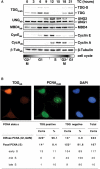Cell cycle regulation as a mechanism for functional separation of the apparently redundant uracil DNA glycosylases TDG and UNG2
- PMID: 17526518
- PMCID: PMC1920262
- DOI: 10.1093/nar/gkm337
Cell cycle regulation as a mechanism for functional separation of the apparently redundant uracil DNA glycosylases TDG and UNG2
Abstract
Human Thymine-DNA Glycosylase (TDG) is a member of the uracil DNA glycosylase (UDG) superfamily. It excises uracil, thymine and a number of chemical base lesions when mispaired with guanine in double-stranded DNA. These activities are not unique to TDG; at least three additional proteins with similar enzymatic properties are present in mammalian cells. The successful co-evolution of these enzymes implies the existence of non-redundant biological functions that must be coordinated. Here, we report cell cycle regulation as a mechanism for the functional separation of apparently redundant DNA glycosylases. We show that cells entering S-phase eliminate TDG through the ubiquitin-proteasome system and then maintain a TDG-free condition until G2. Incomplete degradation of ectopically expressed TDG impedes S-phase progression and cell proliferation. The mode of cell cycle regulation of TDG is strictly inverse to that of UNG2, which peaks in and throughout S-phase and then declines to undetectable levels until it appears again just before the next S-phase. Thus, TDG- and UNG2-dependent base excision repair alternates throughout the cell cycle, and the ubiquitin-proteasome pathway constitutes the underlying regulatory system.
Figures





Similar articles
-
[Uracil-DNA glycosylases].Postepy Biochem. 2008;54(4):362-70. Postepy Biochem. 2008. PMID: 19248582 Review. Polish.
-
Repair of deaminated base damage by Schizosaccharomyces pombe thymine DNA glycosylase.DNA Repair (Amst). 2008 Dec 1;7(12):1962-72. doi: 10.1016/j.dnarep.2008.08.006. Epub 2008 Sep 25. DNA Repair (Amst). 2008. PMID: 18789404
-
The rate of base excision repair of uracil is controlled by the initiating glycosylase.DNA Repair (Amst). 2008 Nov 1;7(11):1869-81. doi: 10.1016/j.dnarep.2008.07.012. Epub 2008 Sep 4. DNA Repair (Amst). 2008. PMID: 18721906
-
Different organization of base excision repair of uracil in DNA in nuclei and mitochondria and selective upregulation of mitochondrial uracil-DNA glycosylase after oxidative stress.Neuroscience. 2007 Apr 14;145(4):1201-12. doi: 10.1016/j.neuroscience.2006.10.010. Epub 2006 Nov 13. Neuroscience. 2007. PMID: 17101234
-
Uracil in DNA--occurrence, consequences and repair.Oncogene. 2002 Dec 16;21(58):8935-48. doi: 10.1038/sj.onc.1205996. Oncogene. 2002. PMID: 12483510 Review.
Cited by
-
An inverse switch in DNA base excision and strand break repair contributes to melphalan resistance in multiple myeloma cells.PLoS One. 2013;8(2):e55493. doi: 10.1371/journal.pone.0055493. Epub 2013 Feb 6. PLoS One. 2013. PMID: 23405159 Free PMC article.
-
Characterizing Requirements for Small Ubiquitin-like Modifier (SUMO) Modification and Binding on Base Excision Repair Activity of Thymine-DNA Glycosylase in Vivo.J Biol Chem. 2016 Apr 22;291(17):9014-24. doi: 10.1074/jbc.M115.706325. Epub 2016 Feb 25. J Biol Chem. 2016. PMID: 26917720 Free PMC article.
-
The TET-TDG axis in T cells and biological processes.Int Immunol. 2025 May 21;37(6):299-312. doi: 10.1093/intimm/dxaf006. Int Immunol. 2025. PMID: 39921704 Review.
-
MBD4 and TDG: multifaceted DNA glycosylases with ever expanding biological roles.Mutat Res. 2013 Mar-Apr;743-744:12-25. doi: 10.1016/j.mrfmmm.2012.11.001. Epub 2012 Nov 26. Mutat Res. 2013. PMID: 23195996 Free PMC article. Review.
-
Cell cycle-specific UNG2 phosphorylations regulate protein turnover, activity and association with RPA.EMBO J. 2008 Jan 9;27(1):51-61. doi: 10.1038/sj.emboj.7601958. Epub 2007 Dec 13. EMBO J. 2008. PMID: 18079698 Free PMC article.
References
-
- Krokan HE, Drablos F, Slupphaug G. Uracil in DNA – occurrence, consequences and repair. Oncogene. 2002;21:8935–8948. - PubMed
-
- Barnes DE, Lindahl T. Repair and genetic consequences of endogenous DNA base damage in mammalian cells. Annu. Rev. Genet. 2004;38:445–476. - PubMed
-
- Slupphaug G, Eftedal I, Kavli B, Bharati S, Helle NM, Haug T, Levine DW, Krokan HE. Properties of a recombinant human uracil-DNA glycosylase from the UNG gene and evidence that UNG encodes the major uracil-DNA glycosylase. Biochemistry. 1995;34:128–138. - PubMed
-
- Haushalter KA, Todd Stukenberg MW, Kirschner MW, Verdine GL. Identification of a new uracil-DNA glycosylase family by expression cloning using synthetic inhibitors. Curr. Biol. 1999;9:174–185. - PubMed
-
- Hendrich B, Hardeland U, Ng HH, Jiricny J, Bird A. The thymine glycosylase MBD4 can bind to the product of deamination at methylated CpG sites. Nature. 1999;401:301–304. - PubMed

